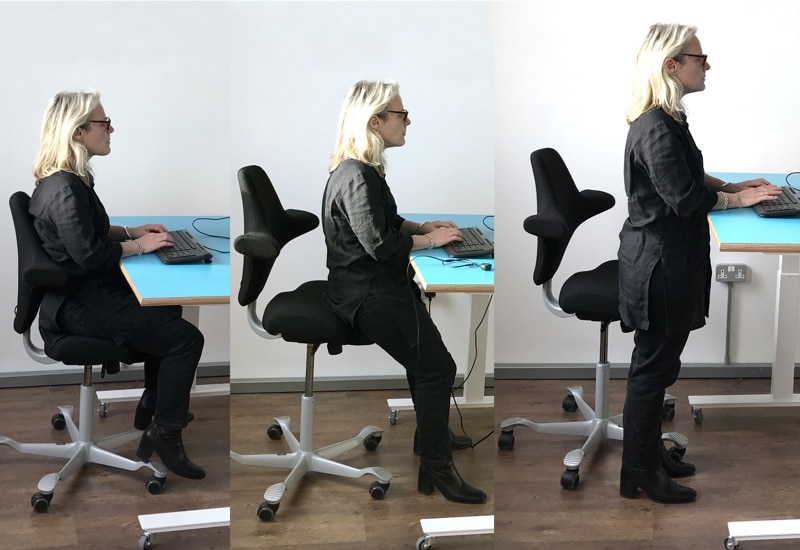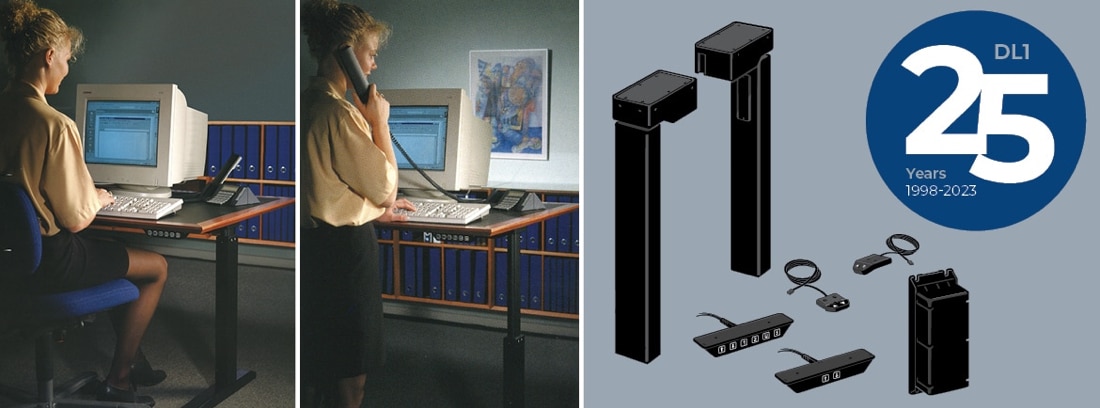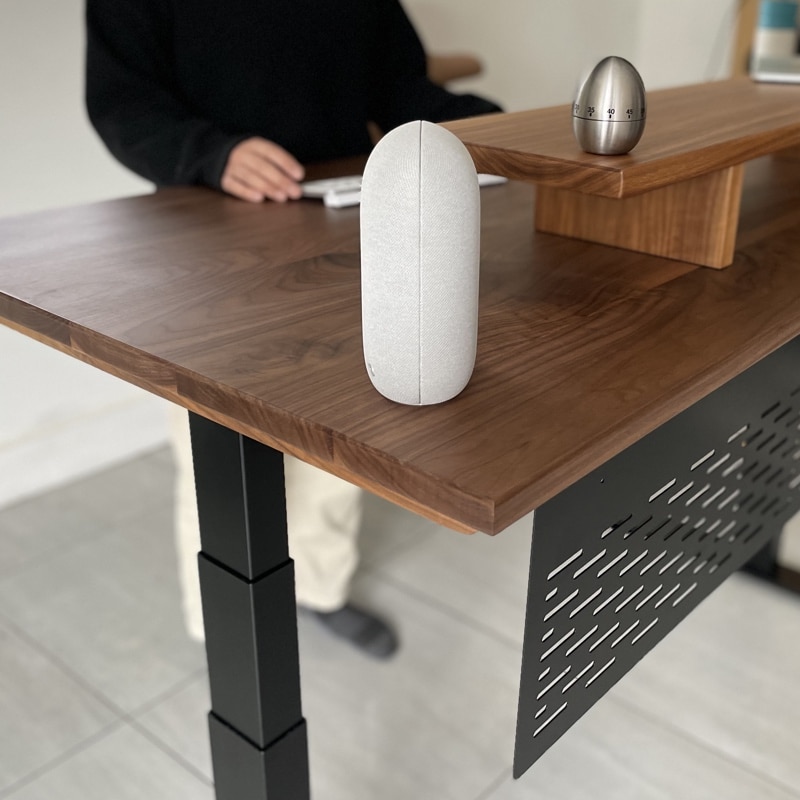The Benefits of a Sit-Stand Desk
Content
Introduction
Introduction
Welcome to the hustle and bustle of the modern workplace, where the daily routine often involves hours spent tethered to a desk and inactive! As we navigate the increasingly digital world, the sedentary epidemic has become an unwelcome companion, often leading to a myriad of health issues, diminished productivity and a drain on our energy levels.

But fear not, for there’s a helpful hand on the horizon – the sit-stand desk, a beacon of hope in the ergonomic landscape.
Picture this: the clock ticking away as your body protests the hours spent in a static seated position. The urgent need for a change reverberates through your body. This is where the sit-stand desk emerges as a practical tool, offering a dynamic alternative to the traditional office desk setup. It’s not just a piece of furniture; it’s a stride towards combating fatigue and embracing more movement in the workplace.
Here, we explore the benefits of sit-stand desks. Join us as we delve into the challenges posed by our sedentary ways, the rise of standing desks as a game-changer, and the urgent need to revolutionise the way we work for our well-being. It’s a call to action!
Ready to stand tall and work well?

Here, we explore the benefits of sit-stand desks. Join us as we delve into the challenges posed by our sedentary ways, the rise of standing desks as a game-changer, and the urgent need to revolutionise the way we work for our well-being. It’s a call to action!
Ready to stand tall and work well?
The Sedentary Lifestyle Epidemic
The Sedentary Lifestyle Epidemic
In the pursuit of deadlines, targets and the ever growing to-do lists we often find ourselves glued to our screens, unknowingly succumbing to the seductive embrace of a sedentary lifestyle. The consequences? A symphony of aching backs, tight hips, a stiff neck and a pervasive sense of fatigue that lingers long after the workday ends.
Defining the Problem
As we continue working in this way the toll on our bodies becomes increasingly evident. Health issues associated with a sedentary lifestyle vary from,
- Poor circulation
- Tight hip flexors lead to decreased mobility
- Slouching can cause undue stress to the ligaments of the spine
- Links to high blood pressure and heart disease
- Bent forward posture affects our breathing
- Increased risk of diabetes
“It’s not completely understood why sitting seems to be associated with a range of health conditions, but the most plausible explanation is that it puts your body into standby..”
When you do it for long enough, your metabolism slows, circulation is constricted and your ability to deal with glucose is compromised. You are effectively switching off some of your body’s largest muscles, with results that can range from increased waist size to diabetes risk.”
Source: The Guardian.
It’s a silent epidemic, one that demands our attention and a proactive approach.
Highlighting the Prevalence of Sedentary Workstations
Let’s talk numbers.
The European Agency for Safety and Health at Work reported a staggering 66% of office workers grapple with musculoskeletal pain* (MSD), a persistent adversary that manifests primarily as back and neck pain rooted in their sedentary workstations.
These are not just isolated cases; they represent a pervasive challenge faced by a substantial majority of the workforce. The repercussions of this widespread discomfort extend far beyond the immediate twinges and soreness.
Each year, a daunting 31 million workdays are lost due to musculoskeletal pain*. That’s not just a statistic; it’s a tangible impact on productivity, job satisfaction, and the overall well-being of the workforce. The toll is not merely physical; it seeps into the fabric of our daily working life, affecting focus, concentration, productivity and creativity – the ability to perform at our best.
As the clock ticks away in workplaces across the world, the silent struggle against musculoskeletal pain persists, echoing throughout office corridors across the UK. The urgent need for a solution becomes evident, not just for the sake of comfort but to salvage the millions of workdays lost to this silent epidemic – one solution lies in our hands, or rather, in our desks.
The Rise of Sit Stand Desks
The Rise of Sit Stand Desks
In the ever-evolving landscape of workplace design, over the last 10 years a transformative trend has gained momentum – the rise of sit-stand desks. Sit-stand desks, the unsung heroes of the contemporary workspace, defy the traditional concept of a static desk.
Throughout history, various figures and cultures have adopted standing workstations for different reasons, including health considerations and ergonomic preferences. With simple standing desks having been around for centuries. With the likes of Leonardo Da Vinchi, Charles Dickens, Ernest Hemingway and Virgina Woolf having used standing desks. Thomas Jefferson, the third President of the United States, is often credited with using a standing desk, which was a simple wooden structure with a slanted writing surface.


In recent years, there has been a resurgence of interest in sit-stand desks due to growing awareness of the potential health benefits associated with more movement and variation in posture during the workday.
Sit-stand desks also known as standing desks or height-adjustable desks have been around for centuries but the technology behind an electric sit-stand desk is a relatively new development and has only been around for a little over two decades. Other types of manual height-adjustment including crank, pin, gas and pneumatic have been around for decades, but nothing compares to the convenience of pushing a button to achieve better ergonomics, health, and well-being while working at your desk.
In late 1998, LINAK caught the industry by surprise and launched the first ever complete electrically height-adjustable system for desks.

Today, sit-stand desks come in various designs, these innovative workstations empower users to seamlessly transition between sitting, perching and standing positions. Injecting a breath of fresh air into the conventional office setup. Sit-stand desks adapt to your body’s needs and actively promote movement, fostering a more dynamic, energised work routine.
Advantages of Sit-Stand Desks
Advantages of Sit-Stand Desks
- Movement stimulates the creation of new brain cells, improving memory, helping to combat the corrosive effects of too much cortisol (a product of chronic stress)*
- When the desk, chair and screens are set up correctly following ergonomic principles, a sit-stand desk allows you the flexibility to follow best practice. For example, it’s easier to keep your arms at a 90-degree angle and wrists level, reducing pains and strains because you can make micro adjustments to your desk set up.
- Raises awareness of our posture, especially when standing as you’re more connected to what your bodies are doing. With this growing awareness, over time this can alleviate the bad habits we’ve developed over time, that puts strain on the neck, shoulders and lower back.
- Being more active and less sedentary reduces the risk of chronic diseases, such as obesity, diabetes and cancer*
- By standing and moving more, participants involved in clinical trials reported reduced fatigue and a greater sense of well-being.
* see external reference links below.
Elevating Metabolism With Standing
Standing is a powerful ally in the quest for a healthier metabolism.
By opting to stand, you activate mechanisms that contribute to the regulation of vital physiological aspects such as blood pressure, blood sugar levels, and the breakdown of body fat. The act of standing itself becomes a calorie-burning endeavour, with an average expenditure of around 50 calories per hour*
In a revealing study focused on office workers, the impact of alternating between sitting and standing every half an hour throughout the day became evident. This simple yet effective practice led to a remarkable 11% reduction in blood sugar spikes*.
The findings underscore the transformative potential of incorporating standing into our daily routines, not just as a means to burn calories but as a proactive measure in promoting metabolic health.
* see external reference links below.
The Growing Trend: A Strategic Response to Workplace Wellness
The buzz around sit-stand desks is not merely a passing fad; it’s a response to the urgent call for change in how we approach our workstations.
Employers and employees alike are recognising the imperative to counteract the detrimental effects of prolonged sitting. Companies are increasingly embracing sit-stand desks as part of their wellness initiatives, understanding that investing in the health and vitality of their workforce pays dividends in productivity and job satisfaction.
Companies that are known for providing sit-stand desks include,
- Microsoft
- Adobe
- Cisco Systems
As we wrestle with the rapidly evolving landscape of workplace wellbeing, the sit-stand desk emerges as a tool to help people move more, pushing back against a sedentary lifestyle that plays havoc with our posture, flexibility, health and overall well-being. It’s not just about standing up; it’s about standing out in the pursuit of a workplace revolution.
Optimising Productivity
Optimising Productivity
1. Adjusting to Your Sit-Stand Desk
The liberation of a sit-stand desk from prolonged periods of immobility is akin to an epiphany. The ability to perch, stand and use a stool offers a paradigm shift that promises many advantages.
Crafting an individual routine that builds over time.
- Start your day by standing for an hour before settling into a seated position, while aligning the task at hand with your posture.
- Individuals engaged in tasks requiring intense concentration, such as writing or designing, often find productivity while seated.
- In contrast, those engaged in expressive phone conversations prefer standing to sitting, leveraging body language.
- The afternoon energy slump affects people differently; some find sitting a preference, while others discover productivity in standing.
Attaining ergonomic precision is crucial; gradually acclimate to extended standing periods over time, you could also consider using an anti-fatigue mat for enhanced comfort. Your patience is an investment your body will appreciate.

Consider incorporating a simple timer as an ally; it serves as a subtle reminder amidst the immersive world of computer work, preventing prolonged sitting for hours.
2. Establishing a Routine
Many sit-stand desks feature height control panels with programmable memory options, although none match the innovative functionality of the new award winning DPi1C Panel.
Once these pre-sets align with your optimum ergonomic height, the hassle of constant adjustment fades into the background.
The aim is for balance, try to avoid days dominated by either prolonged sitting or standing.
Encouraging Long-Term Benefits: A Holistic Approach
Sit-stand desks are not a one-size-fits-all solution, and success lies in understanding and addressing individual needs. By acknowledging and proactively overcoming ingrained sedentary habits, organisations and individuals can ensure a smooth and effective integration of sit-stand desks into the workplace, promoting a culture of well-being and sustained productivity.
It’s not just about standing; it’s about standing together in the pursuit of a healthier work experience.

Standing Desk User Experiences
Standing Desk User Experiences
At Flomotion, our aim is to provide professionals with the tools to implement active, agile and smart working initiatives into the workplace.
We build professional relationships with our clients through providing a streamlined service specialised in designing high-quality solid wood sit-stand desks, contemporary design-led furniture with seamless and functional accessories.
Working with professionals we’ve found flexible, hybrid working has allowed a range of industries, from architects to designers, barristers, solicitors, music producers, accountants and the financial sector – to find the right work balance, whether that’s in the office or working from home or a mix of both. The one thing they’ve all had in common – sedentary working!
We believe sit-stand active working is the future. Here’s what a few of our customers have to say too.
“Absolutely love my desk – it has absolutely transformed my working from home experience. It has made such a difference to stand during long meetings, my back pain has massively improved.”
“Really pleased with the desk and chair I got from the team. The desk has a complete video editing set up upon it and the desk handles the weight no problem. Having spent the last two years hunched over static desks for days at a time – leading me to see chiropractors every other month (which at 22 is not what I should be doing) – I’m extremely excited about my new ways of working. After only a couple of weeks use I’m already noticing the benefits. Really friendly and efficient team, they dropped and set up the desk in the space of a couple of hours. After getting the desk set optimally for my measurements, we were then able to talk about some of the other practices involved with active working, so many simple tips that I’d never have thought of. Would highly recommend these guys particularly down to the quality of there product. I had tried a few other sit-stand desks but none felt quite as well built as theirs.”
“For medical reasons I needed a standing desk. I spent a lot of time considering the many options before dropping into Flomotion’s studio, in Norwich, for a demonstration. Bev and Jacob were great, walking me through the pros and cons and the Flomotion range. As a result, I ordered a desk with a custom worktop to fit my space. This took a few weeks to be manufactured, and then Jacob delivered and set it up for me. The quality is superb, and the service has been excellent from start to finish. Overnight, the desk has tranformed the way I work. My need for a standing desk was more or less forced on me, but I’m a true convert: I feel more alert throughout the day, and I’m surprised to find I actually prefer standing to sitting while working. Flomotion’s prices are perhaps on the premium side but here at least I can attest that the old adage is true – you get what you pay for.”
For more information on how we can help you, send us an email at hello@flomotionstudio.co.uk, give us a call on 01603 951595 or take a look at our resources.
External References
External References
https://www.theguardian.com/lifeandstyle/2023/may/14/should-i-worry-about-how-long-i-spend-sitting-down#:~:text=It’s%20not%20completely%20understood%20why,deal%20with%20glucose%20is%20compromised – The Guardian, Should I worry about how long I spend sitting down?
https://osha.europa.eu/sites/default/files/Work-related_MSDs_prevalence_costs_and_demographics_in_the_EU_report.pdf – European Agency for Safety and Health at Work, Work-related musculoskeletal disorders: prevalence, costs and demographics in the EU.
https://societyofauthors.org/SOA/MediaLibrary/SOAWebsite/Documents-for-download/musculoskeletal_health_in_the_workplace.pdf – Business in the Community, in association with Public Health England, Musculoskeletal health in the workplace: a toolkit for employers.
https://www.ncbi.nlm.nih.gov/pmc/articles/PMC5808288/pdf/fnins-12-00052.pdf – Frontiers in Neuroscience, Exercise-Mediated Neurogenesis in the Hippocampus via BDNF
https://www.ncbi.nlm.nih.gov/pmc/articles/PMC7700832/pdf/kjfm-20-0165.pdf Korean Journal of Family Medecine, Sedentary Lifestyle: Overview of Updated Evidence of Potential Health Risks.
https://pubmed.ncbi.nlm.nih.gov/24637345/ Med Sci Sports Exerc, Alternating bouts of sitting and standing attenuate postprandial glucose responses.




